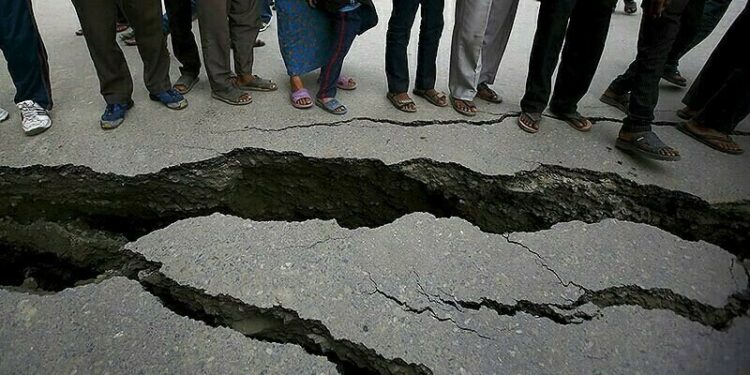LAHORE – A 4.4 magnitude earthquake struck parts of Punjab on Tuesday morning, jolting residents in Lahore and surrounding cities. The seismic activity, which occurred at approximately 11:39 AM, was felt in major cities including Kasur, Okara, Nankana Sahib, Sheikhupura, Muridke, and Kamoke. The tremors sent panic across the region, prompting citizens to evacuate homes and buildings, many of them reciting the Kalima Tayyaba in fear.
This incident marks a rare occurrence of noticeable seismic activity in central Punjab, a region historically less prone to significant earthquakes compared to the country’s northwestern areas.
Details of the Earthquake: Magnitude, Depth, and Epicenter
According to data released by Pakistan’s Metrological Department, the earthquake registered a magnitude of 4.4 on the Richter scale. The epicenter was located southwest of Lahore, while the depth of the tremor was recorded at 14 kilometers, a relatively shallow depth that made the shocks more noticeable on the surface.
Earthquakes at shallow depths typically cause stronger surface-level shaking, which likely contributed to the widespread reaction observed across multiple cities in Punjab. Although the magnitude was moderate, the geographical proximity of the epicenter to major urban centers such as Lahore amplified the perceived intensity.
Cities Affected Across Punjab
In addition to Lahore, earthquake tremors were clearly felt in several nearby cities and districts. The affected areas included:
- Kasur
- Okara
- Sheikhupura
- Nankana Sahib
- Muridke
- Kamoke
In all these locations, the tremors caused momentary panic among residents. Many people ran outside of their homes, workplaces, and schools, fearing a possible stronger quake or aftershock.
Public Reaction: Fear, Prayer, and Evacuation
As the earthquake struck unexpectedly, widespread panic ensued. Eyewitnesses reported that many individuals, particularly in Lahore, fled buildings and homes immediately after feeling the tremors. The Kalima Tayyaba echoed in streets and public spaces as people sought divine protection.
Social media was quickly flooded with real-time updates, videos, and messages of concern. Many residents reported items shaking, hanging lights swaying, and minor structural vibrations in buildings. Fortunately, no immediate reports of damage or casualties were issued, though authorities have continued inspection efforts across the affected areas.
Emergency Response: PDMA Activates Safety Protocols
The Provincial Disaster Management Authority (PDMA) sprang into action following the quake. The Director General of PDMA issued a statement assuring the public that the provincial administration had been placed on high alert. Teams were dispatched across affected cities to conduct structural safety assessments, especially in vulnerable buildings.
Machinery and emergency response units were put on standby, with instructions to be prepared for potential aftershocks. The PDMA also issued public guidance on earthquake safety and urged residents to stay outdoors if they felt unsafe, to avoid crowded or high-rise structures until authorities confirmed safety.
The DG PDMA emphasized the importance of following earthquake safety protocols, including:
- Avoiding use of elevators during tremors
- Staying away from windows and glass structures
- Taking shelter under sturdy furniture if indoors
- Moving to open spaces if possible
Seismic Activity Increasing Across Pakistan
This earthquake in Punjab follows a series of tremors reported in other parts of Pakistan in recent weeks. Karachi, the financial hub in southern Pakistan, has experienced several low-intensity earthquakes, creating unease among residents. Similarly, Khyber Pakhtunkhwa and Balochistan, which lie near major fault lines, have also witnessed intermittent seismic events.
While northern Pakistan lies along the boundary between the Indian and Eurasian tectonic plates, and is known for frequent and sometimes severe earthquakes, central Punjab has historically experienced less seismic activity. However, the recent tremors suggest a possible shift in fault activity, warranting greater geological scrutiny and public preparedness.
Understanding Pakistan’s Seismic Risk
Pakistan is located in a seismically active region, with the Himalayan orogeny and multiple fault lines contributing to frequent earthquakes. The Main Boundary Thrust and Main Frontal Thrust fault systems, which run through northern Pakistan, are responsible for many of the country’s large earthquakes, including the devastating 2005 Kashmir earthquake that killed over 80,000 people.
In recent years, scientists have raised concerns about urban expansion in quake-prone areas without adequate seismic planning. Lahore, though not at the epicenter of major fault lines, lies close enough to active seismic zones to experience mild to moderate tremors, especially when deeper tectonic movements ripple across the region.
Past Earthquakes in Punjab: A Rare but Real Threat
Punjab has not historically been a hotbed of seismic activity, but it is not immune. Over the past decade, several mild tremors have been reported, most of them causing no significant damage. However, with increasing population density and vertical construction in cities like Lahore and Faisalabad, the risk of future damage from even moderate earthquakes cannot be ignored.
This latest 4.4 magnitude quake should serve as a wake-up call for urban planners, civil engineers, and government officials to strengthen building codes, especially for schools, hospitals, and multi-story residential complexes.
Safety Tips and Public Awareness
In the aftermath of such events, authorities urge the public to educate themselves about basic earthquake preparedness. Here are key safety tips:
- Before an Earthquake: Secure heavy items, have an emergency kit ready, and know your evacuation plan.
- During an Earthquake: Drop, cover, and hold on. Stay indoors until the shaking stops unless it’s unsafe.
- After an Earthquake: Check for injuries and damage. Avoid using elevators and remain cautious of aftershocks.
Educational campaigns are needed to instill these practices in communities, particularly in areas previously considered low-risk like Punjab.
Conclusion: Preparedness Is Key as Seismic Activity Expands
While Tuesday’s earthquake in Lahore and surrounding cities did not cause physical damage, it certainly shook public confidence. The 4.4 magnitude tremor, felt across multiple districts in Punjab, serves as a timely reminder that no part of Pakistan is entirely free from seismic threats.
Authorities, including PDMA and local administrations, have rightly responded with caution and readiness. However, long-term resilience will depend on improved infrastructure, public awareness campaigns, and updated disaster management protocols.
As Punjab experiences this new wave of seismic activity, it is vital for both the government and citizens to remain vigilant, informed, and prepared for what may come next. With proper planning and response, the province can minimize the impact of future earthquakes and safeguard lives and property.

























